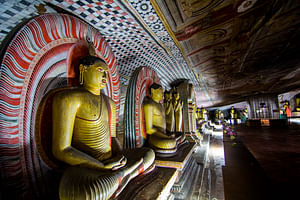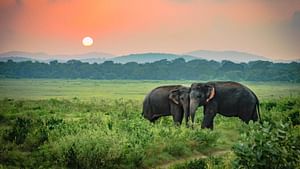Jaffna is far and away from the largest town in northern Sri Lanka and the undisputed cultural capital of the Sri Lankan Tamil peoples. Visit magnificent Hindu Kovils and stunning beaches while being able to savory Jaffna curry and incredible boat safari to the famous Naga Deepa Temple. Explore Murunkandy Kovil & attend rituals with an opportunity to gang of the elephants to drink in the most popular elephant pass as you proceed along with the Palmyra three to Jaffna. Visit a serene evening Nalur Kovila and Jaffna city tour. Finally, being able to explore the Buddhist temple of Nagadeepa with an amazing boat ride across the Indian Ocean.
Highlights
Explore the Hindu Kovil in Jaffna
Discover the Nagadeepa temple by boat
Visit and enjoy at Elephant Pass
Enjoy stunning beach in Jaffna Peninsula
Duration
The tour starts at
-
Day 1
Colombo to Jaffna
Colombo to Jaffna
-
Day 1
Remote and war-torn JAFFNA is far and away the largest town in northern Sri Lanka and the undisputed cultural capital of the Sri Lankan Tamils, who have controlled the area since the thirteenth centur...
Remote and war-torn JAFFNA is far and away the largest town in northern Sri Lanka and the undisputed cultural capital of the Sri Lankan Tamils, who have controlled the area since the thirteenth century. The town was the focal point of many of the early civil war’s fiercest battles, although having remained under government control since 1995 it at least avoided being caught up in the devastating fighting which enveloped the rest of northern Sri Lanka during 2008–09. Largely inaccessible for over two decades, Jaffna is now once again freely open to visitors, still unexpectedly vibrant, despite its many years of isolation, and, in places, strangely beautiful.
-
Day 2
Jaffna
Jaffna
-
Day 2
Jaffna is closer to India than to Colombo, and in many ways looks across the Palk Strait to the Indian state of Tamil Nadu rather than to Sinhalese Sri Lanka for its cultural and political inspiration...
Jaffna is closer to India than to Colombo, and in many ways looks across the Palk Strait to the Indian state of Tamil Nadu rather than to Sinhalese Sri Lanka for its cultural and political inspiration. Arriving in Jaffna can come as something of a culture shock if you’ve spent much time in the rest of the island, and you can’t fail to notice the profound Indian influence here, exemplified by the replacement of the Buddhist dagoba with the Hindu gopuram, and by the switch from the singsong cadences of Sinhala to the quickfire intonations of Tamil – as well as myriad other details like the sultry Indian pop music which blares out of shops and cafés, and the quasi-subcontinental hordes of kamikaze cyclists who rattle around the congested streets.
-
Day 2
The Nagadeepa Purana Rajamaha Viharaya is one of the sixteen most sacred places of worship by the Buddhists in Sri Lanka. Pilgrims have been coming to Nagadeepa since about the 1st century AC to worsh...
The Nagadeepa Purana Rajamaha Viharaya is one of the sixteen most sacred places of worship by the Buddhists in Sri Lanka. Pilgrims have been coming to Nagadeepa since about the 1st century AC to worship at its famous Rajayathana stupa. The Rajayathana stupa was constructed by two warring Naga kings, Chulodara and Mahodara, at the site where Lord Buddha during His second visit to the country on a Bak Maha Amawaka Poya Day, five years after attaining Enlightenment, intervened and mediated in settling a dispute over the possession of a gem-studded throne.
-
Day 2
Jaffna’s most notable sight is the large Nallur Kandaswamy Temple, about 2km northeast of the town centre. Dedicated to Murugan (known to the Buddhist Sinhalese as Kataragama), this is the most impr...
Jaffna’s most notable sight is the large Nallur Kandaswamy Temple, about 2km northeast of the town centre. Dedicated to Murugan (known to the Buddhist Sinhalese as Kataragama), this is the most impressive Hindu temple in Sri Lanka, and the only one on the island to rival the great shrines of India. The original temple is thought to date back to the mid-fifteenth century, though it was destroyed in 1620 by the Portuguese. The present structure was begun in 1807 and has now developed into an enormous religious complex, surrounded by red-and-white striped walls. There are numerous shrines inside, richly decorated corridors framed in rows of golden arches and a beautiful courtyard with a large tank. Men must remove their shirts before entering. There are no fewer than six pujas daily, with three between 4pm and 5pm, the best time to visit.
-
Day 3
Jaffna
Jaffna
-
Day 3
Jaffna is closer to India than to Colombo, and in many ways looks across the Palk Strait to the Indian state of Tamil Nadu rather than to Sinhalese Sri Lanka for its cultural and political inspiration...
Jaffna is closer to India than to Colombo, and in many ways looks across the Palk Strait to the Indian state of Tamil Nadu rather than to Sinhalese Sri Lanka for its cultural and political inspiration. Arriving in Jaffna can come as something of a culture shock if you’ve spent much time in the rest of the island, and you can’t fail to notice the profound Indian influence here, exemplified by the replacement of the Buddhist dagoba with the Hindu gopuram, and by the switch from the singsong cadences of Sinhala to the quickfire intonations of Tamil – as well as myriad other details like the sultry Indian pop music which blares out of shops and cafés, and the quasi-subcontinental hordes of kamikaze cyclists who rattle around the congested streets.
-
Day 4
Jaffna to Colombo
Jaffna to Colombo
-
Day 4
Jaffna is closer to India than to Colombo, and in many ways looks across the Palk Strait to the Indian state of Tamil Nadu rather than to Sinhalese Sri Lanka for its cultural and political inspiration...
Jaffna is closer to India than to Colombo, and in many ways looks across the Palk Strait to the Indian state of Tamil Nadu rather than to Sinhalese Sri Lanka for its cultural and political inspiration. Arriving in Jaffna can come as something of a culture shock if you’ve spent much time in the rest of the island, and you can’t fail to notice the profound Indian influence here, exemplified by the replacement of the Buddhist dagoba with the Hindu gopuram, and by the switch from the singsong cadences of Sinhala to the quickfire intonations of Tamil – as well as myriad other details like the sultry Indian pop music which blares out of shops and cafés, and the quasi-subcontinental hordes of kamikaze cyclists who rattle around the congested streets.
Breakfast
Air-conditioned vehicle
Professional English chauffeur guide
All accommodation
All government taxes
Flights & visas
Optional activities
Medical & travel insurance
Tips
Entrance fees to all sites and monuments as per itinerary














